Late one night, you’re scrolling through your phone, head propped up by one tired hand, watching over your baby who finally drifted off after a long, fussy evening. Then you see it: an ad for a tiny sock-like monitor that promises to track your infant’s heart rate and oxygen levels. The video feels like it was made just for you soothing music, a peaceful sleeping baby, and a reassuring voice promising that if something goes wrong, you’ll be the first to know. It’s hard not to think, “If this gadget could possibly save my baby’s life, why wouldn’t I buy it?” That emotional tug, that subtle fear, is exactly what these companies count on.
But here’s the hard truth: while these high-tech monitors have flooded the market in recent years, the evidence suggests they’re often not as reliable and certainly not as helpful as their sleek packaging implies. In fact, some respected paediatricians, researchers, and organizations have publicly questioned their value. Before you shell out a small fortune in the hope of better sleep and peace of mind, it’s worth digging deeper into what these devices really do, what they don’t do, and what all of that means for you and your baby.





